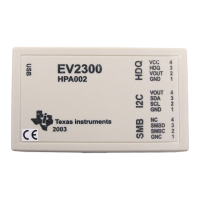Lab 9: DSP/BIOS
27. Next, open the execution graph. On the menu bar click:
DSP/BIOS Execution Graph
The execution graph is a special graph used to display information about different threads
in the system and when they occur relative to the other events. This graph is not based on
time, but the activity of events (i.e. when an event happens, such as a SWI or periodic
function begins execution). You can enable or disable logging for each of the object
types using the RTA Control Panel (DSP/BIOS RTA Control Panel). Note
that the execution graph simply records DSP/BIOS CLK events along with other system
events (the DSP/BIOS clock periodically triggers the DSP/BIOS scheduler). As a result,
the time scale on the execution graph is not linear.
28. Halt the DSP.
29. In the next few steps the Log Event Manager will be setup to capture an event in real-
time while the program executes. We will be using Log_printf() to write to a log
buffer. The LOG_printf() function is a very efficient means of sending a message
from the code to the CCS display. Unlike an ordinary C-language printf(), which can
consume several hundred DSP cycles to format the data on the DSP before transmission
to the CCS host PC, a log_printf() transmits the raw data to the host. The host then
formats the data and displays it in CCS. This consumes only 10’s of cycles rather than
100’s of cycles.
Add the following to Main_9.c just after the static local variable declaration in
AdcSwi():
static Uint32 AdcSwi_count=0; // used for LOG_printf
/*** Using LOG_printf() to write to a log buffer ***/
LOG_printf(&trace, "AdcSwi_count = %u", AdcSwi_count++);
30. In the configuration file Lab.cdb we need to add and setup the trace buffer. Open
Lab.cdb and click on the plus sign (+) to the left of Instrumentation and again on
the plus sign (+) to the left of LOG – Event Log Manager.
31. Right click on LOG – Event Log Manager and select Insert LOG. LOG0 will
be added. Right-click on it and rename it to trace.
32. Select the Properties for trace and set the logtype to circular and the datatype to
printf. Click OK.
33. Since the configuration file was modified, we need to rebuild the project. Click the
“Build” button.
34. Reset the DSP.
35. Open the Message Log by clicking:
DSP/BIOS Message Log
9 - 20 C28x - Using DSP/BIOS

